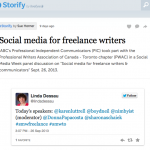Twitter comments are fleeting, and a time that’s convenient to a few may not be to everyone. That’s why it’s helpful to collect the tweets into a conversation that can be saved and others can read later.
You collect – or curate, if you’d rather use the usual buzzword – public tweets, pictures, video and other content from around the web to publish as a story. It’s great for summarizing a meeting or conference, relating a conversation or collecting reaction.
I used to use a service called Storify (no longer available) to collect tweets, which of course makes me an expert qualified to share with you my do’s and don’ts for compiling these collections (now done through Twitter Moments):
DO find conversations using keywords or the humble hashtag, #. IABC holds a monthly #commchat. The Professional Writers Association of Toronto – Toronto chapter shares tweets during professional development sessions using #pwacpanel. Solo PR Pro runs a regular chat for independent PR consultants at #solopr on Wednesdays from 1 to 2 p.m. EST. All summarize their chats.
DO give your story a title that explains the topic under discussion for later reference.
DO be selective. You don’t have to include the icebreaker questions that often start the chats.
DO group all answers to the same question. Moments allows you to pull in all tweets at once, which will appear in the order they showed up. You can click on an arrow to move the answers that appear out of sequence up or down. Please do this.
DO pull out the best tweets, ones that help people make sense of the conversation or learn something new.
DO include a variety of media. Pictures especially add visual appeal to your summary.
DON’T use retweeted messages just to include another person, unless you use it to replace the original message. Otherwise it’s just redundant.
DON’T include apologies from people joining the chat late, even if your reason is to show their participation; just include the interesting comments they make.
DON’T include every single comment. You’re summarizing, not providing a complete transcript (unless you are, in fact, providing a complete transcript).
What other tips would you add?
I used to use a service called Storify that helpfully collected the tweets. Now, Twitter Moments perform a similar service. (My own Storify summaries are now viewable in Wakelet.)
Related posts:
- My summary of a session on fine-tuning your LinkedIn profile
- A summary on social media for freelance writers during Social Media Week Toronto
- A discussion I had on Twitter with Steve Crescenzo on how often to publish an employee newsletter.


These are great tips, Sue. Thanks for sharing. The only thing I would add: to let people know you’ve quoted them in the Storify.
Thanks, Donna! Great point. Storify actually makes it really easy for you to let people know you’ve quoted them by automatically creating a tweet mentioning them.